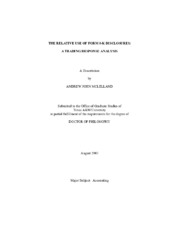| dc.description.abstract | Prior research suggests that the use of accounting information differs substantially by investor class. My analysis extends this line of research to the area of SEC Form 8-K filings. Prior research also provides mixed evidence on the informativeness of these filings. I hypothesize that the method of the disclosure is an important factor in evaluating 8-K usefulness to varying types of investors. Specifically, the timing, venue, and packaging of these accounting disclosures affect their use by investors. Regulation Fair Disclosure (2000) considers both press releases and 8-K filings as broad-based disclosures that do not favor any investor class. I, however, identify five unique informational settings in which 8-K filings occur. The five settings are: a concurrent 8-K event and filing (with or without a press release), a filing which precedes the press release, a press release that precedes the filing, an 8-K event that precedes a filing and/or press release, and the 8-K event alone. I examine the similarities and differences in trading by small and large investors across these settings. The identification of these empirical regularities with respect to disclosure form should be particularly useful to policy makers seeking to implement level playing field objectives with respect to public disclosures. My findings show that the relative trading activity to 8-K filings is different by the type of disclosure. Differential trading activity was found to be more pronounced in disclosure settings that contained a public announcement. In addition, the type of Form 8-K disclosure also had an effect on the differential trading activity. Form 8-K filings of acquisition or disposition of assets were associated with the most pronounced responses. My findings show the differential trading activity to these filings differs from other accounting events such as earnings announcements and annual report filings. | en |


